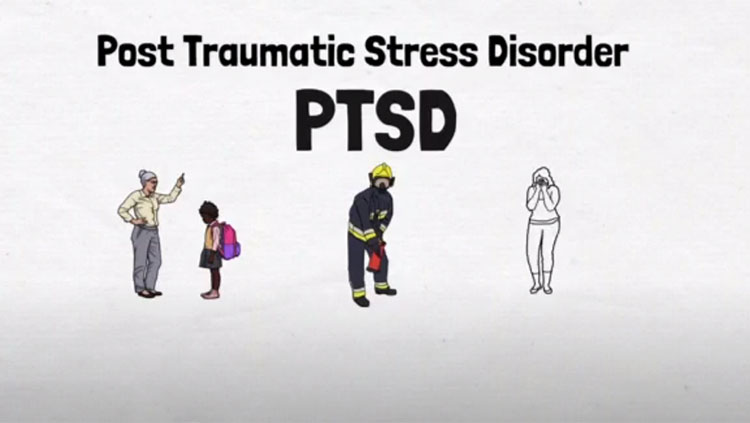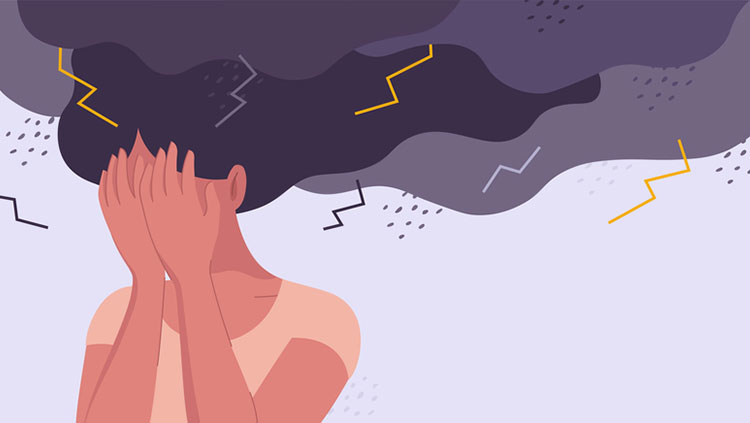Introduction to Common Mental Disorders
- Reviewed15 May 2023
- Author Alison Davis
- Source BrainFacts/SfN

According to World Health Organization data from 2019, 1 in every 8 people, or 970 million people around the world, were living with a mental disorder. A mental disorder is a syndrome characterized by clinically significant disturbances in an individual’s cognition, emotion regulation, and/or behavior — reflecting a dysfunction in the psychological, biological, or development processes underlying their mental functioning.
Like many health conditions, mental disorders, or psychiatric disorders, can be caused by multiple factors. Genes often play a role, with many mental disorders tending to run in families. Yet having a close relative with anxiety, schizophrenia, depression, or another psychiatric condition does not necessarily mean that you will develop the same problem. Many environmental effects, including life circumstances, medical conditions, and personal relationships, also have an influence. Environmental factors can be negative — like the death of a loved one, poverty, addiction, or direct exposure to violence such as abuse or military combat — or they may be protective. Protective factors, called resilience factors, include a strong support system of family and friends, healthy coping mechanisms, being physically active, and involvement in a range of activities.
Anxiety Disorders and Post-Traumatic Stress Disorder
Everyone feels anxious at times, and worrying is a normal and healthy response to uncertainty or potential danger. But incessant, uncontrollable anxiety is a common thread in a variety of psychiatric disorders: post-traumatic stress disorder (PTSD), obsessive-compulsive disorder (OCD), and panic attacks. Collectively, anxiety disorders are the most common mental disorders experienced by people in the United States. They are more common in women, for reasons that are not clear but likely include both sex differences (biological) and gender variations (psychosocial).
Medications used to treat most anxiety disorders work by altering the levels of neurotransmitters that carry signals between brain regions. Selective serotonin reuptake inhibitors (SSRIs) raise serotonin levels, which are known to be deficient in many psychiatric conditions. Benzodiazepines, commonly known as “benzos” such as Xanax or Valium, were once the standard medication for anxiety because they boost levels of the inhibitory neurotransmitter gamma-aminobutyric acid (GABA). GABA acts like a “brake pedal” on neurons, helping to decrease their activity, especially in areas of the brain important in anxiety. However, due to the risk of dependence, benzodiazepines are no longer the first choice for treatment of anxiety.
Mood Disorders
Mood is a general term describing a person’s overall state of mind. You may easily recognize someone in good spirits or, conversely, in a bad mood. Your moods change frequently with your emotional state, and such changes are normal when they suit your circumstances or the context. Mood disorders, on the other hand, are mood changes that last longer and occur independent of what is going on around you.
The two main mood disorders are major depression and bipolar disorder. In recent years, neuroscientists have made major progress in linking genetic and other biological contributors to mood disorders and to disorders of cognition, like schizophrenia, with hopes of developing better treatments for people with more than one condition.
Adapted from the 8th edition of Brain Facts by Alison Davis.
CONTENT PROVIDED BY
BrainFacts/SfN
References
Bandelow, B., & Michaelis, S. (2015). Epidemiology of anxiety disorders in the 21st century. Dialogues in Cclinical Nneuroscience, 17(3), 327–335. https://doi.org/10.31887/DCNS.2015.17.3/bbandelow
Burguière, E., Monteiro, P., Mallet, L., Feng, G., & Graybiel, A. M. (2015). Striatal circuits, habits, and implications for obsessive-compulsive disorder. Current Oopinion in Nneurobiology, 30, 59–65. https://doi.org/10.1016/j.conb.2014.08.008
Craddock, N., & Sklar, P. (2013). Genetics of bipolar disorder. Lancet (London, England), 381(9878), 1654–1662. https://doi.org/10.1016/S0140-6736(13)60855-7
Foland-Ross, L. C., Hamilton, P., Sacchet, M. D., Furman, D. J., Sherdell, L., & Gotlib, I. H. (2014). Activation of the medial prefrontal and posterior cingulate cortex during encoding of negative material predicts symptom worsening in major depression. Neuroreport, 25(5), 324–329. https://doi.org/10.1097/WNR.0000000000000095
Geddes, J. R., & Miklowitz, D. J. (2013). Treatment of bipolar disorder. Lancet (London, England), 381(9878), 1672–1682. https://doi.org/10.1016/S0140-6736(13)60857-0
Kavanagh, D. H., Tansey, K. E., O'Donovan, M. C., & Owen, M. J. (2015). Schizophrenia genetics: emerging themes for a complex disorder. Molecular Ppsychiatry, 20(1), 72–76. https://doi.org/10.1038/mp.2014.148
Memon, M. A. (2018). Panic Disorder. Medscape. http://emedicine.medscape.com/article/287913-overview
National Alliance on Mental Illness. (2017). Depression. https://www.nami.org/Learn-More/Mental-Health-Conditions/Depression
National Institute of Mental Health. (2017). Anxiety Disorders. NIH. https://www.nimh.nih.gov/health/topics/anxiety-disorders/index.shtml
National Institute of Mental Health. (2017). Bipolar Disorder. NIH. https://www.nimh.nih.gov/health/statistics/prevalence/bipolar-disorder-among-adults.shtml
National Institute of Mental Health. (2017). Depression. NIH. https://www.nimh.nih.gov/health/topics/depression/index.shtml
National Institute of Mental Health. (2017). Obsessive-Compulsive Disorder (OCD). NIH. https://www.nimh.nih.gov/health/topics/obsessive-compulsive-disorder-ocd/index.shtml
National Institute of Mental Health. (2017). Panic Disorder. NIH. https://www.nimh.nih.gov/health/statistics/prevalence/panic-disorder-among-adults.shtml
National Institute of Mental Health. (2017). Post-Traumatic Stress Disorder (PTSD). NIH. https://www.nimh.nih.gov/health/statistics/prevalence/post-traumatic-stress-disorder-among-adults.shtml
Pittenger, C., & Bloch, M. H. (2014). Pharmacological treatment of obsessive-compulsive disorder. The Psychiatric Cclinics of North America, 37(3), 375–391. https://doi.org/10.1016/j.psc.2014.05.006
Ragen, B. J., Seidel, J., Chollak, C., Pietrzak, R. H., & Neumeister, A. (2015). Investigational drugs under development for the treatment of PTSD. Expert Opinion on Investigational Drugs, 24(5), 659–672. https://doi.org/10.1517/13543784.2015.1020109
Strube, W., Bunse, T., Nitsche, M. A., Wobrock, T., Aborowa, R., Misewitsch, K., Herrmann, M., Falkai, P., & Hasan, A. (2015). Smoking restores impaired LTD-like plasticity in schizophrenia: a transcranial direct current stimulation study. Neuropsychopharmacology, 40(4), 822–830. https://doi.org/10.1038/npp.2014.275
Treadway, M. T., Waskom, M. L., Dillon, D. G., Holmes, A. J., Park, M. T. M., Chakravarty, M. M., Dutra, S. J., Polli, F. E., Iosifescu, D. V., Fava, M., Gabrieli, J. D. E., & Pizzagalli, D. A. (2015). Illness progression, recent stress, and morphometry of hippocampal subfields and medial prefrontal cortex in major depression. Biological Psychiatry, 77(3), 285–294. https://doi.org/10.1016/j.biopsych.2014.06.018
World Health Organization. (2022). Mental disorders. https://www.who.int/news-room/fact-sheets/detail/mental-disorders
What to Read Next
Also In Mental Health
Trending
Popular articles on BrainFacts.org



















